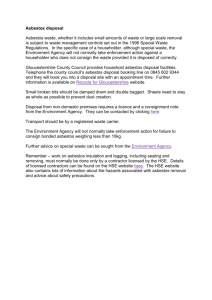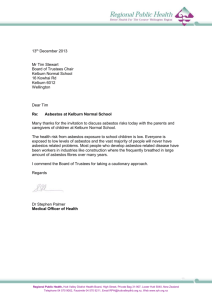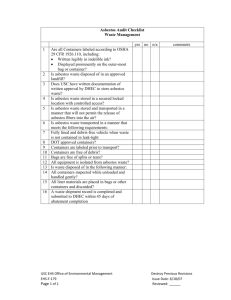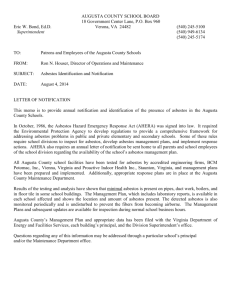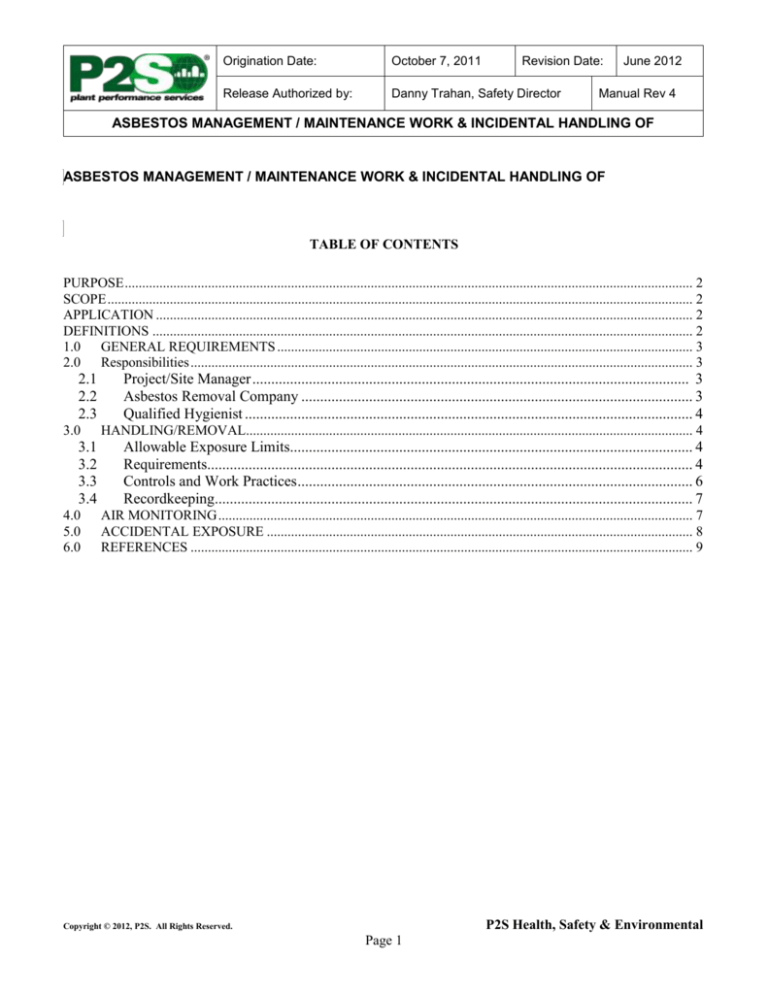
Origination Date:
October 7, 2011
Revision Date:
Release Authorized by:
Danny Trahan, Safety Director
June 2012
Manual Rev 4
ASBESTOS MANAGEMENT / MAINTENANCE WORK & INCIDENTAL HANDLING OF
ASBESTOS MANAGEMENT / MAINTENANCE WORK & INCIDENTAL HANDLING OF
TABLE OF CONTENTS
PURPOSE .................................................................................................................................................................... 2
SCOPE ......................................................................................................................................................................... 2
APPLICATION ........................................................................................................................................................... 2
DEFINITIONS ............................................................................................................................................................ 2
1.0 GENERAL REQUIREMENTS ........................................................................................................................ 3
2.0 Responsibilities ................................................................................................................................................. 3
2.1
2.2
2.3
3.0
3.1
3.2
3.3
3.4
4.0
5.0
6.0
Project/Site Manager .................................................................................................................... 3
Asbestos Removal Company ........................................................................................................ 3
Qualified Hygienist ....................................................................................................................... 4
HANDLING/REMOVAL................................................................................................................................. 4
Allowable Exposure Limits........................................................................................................... 4
Requirements................................................................................................................................. 4
Controls and Work Practices ......................................................................................................... 6
Recordkeeping............................................................................................................................... 7
AIR MONITORING ......................................................................................................................................... 7
ACCIDENTAL EXPOSURE ........................................................................................................................... 8
REFERENCES ................................................................................................................................................. 9
P2S Health, Safety & Environmental
Copyright © 2012, P2S. All Rights Reserved.
Page 1
Origination Date:
October 7, 2011
Revision Date:
Release Authorized by:
Danny Trahan, Safety Director
June 2012
Manual Rev 4
ASBESTOS MANAGEMENT / MAINTENANCE WORK & INCIDENTAL HANDLING OF
PURPOSE
This practice provides the requirements for handling asbestos when it is discovered incidental to other services
provided to a client.
SCOPE
This practice includes the following major sections:
General Requirements
Responsibilities
Handling/Removal
Air Monitoring
Accidental Exposure
APPLICATION
This practice applies to work activities and employees under the control of P2S and its contractors.
DEFINITIONS
Asbestos A naturally occurring mineral fiber with any of the following names:
Chrysotile
Amosite
Crocidolite
Fibrous tremolite
Fibrous anthophyllite
Fibrous actinolite
Asbestos Fiber Asbestos that is 5 micrometers or longer with the length at least 3 times the diameter.
Cemented Asbestos Asbestos that is tightly bound with tar, Portland cement, or other material. Cement pipe or
sheet can emit airborne fibers if the materials are cut, abraded or sawed, or if they are broken during demolition
operations.
Competent Person – One who is capable of identifying existing and predictable hazards in the surroundings or
working conditions which are unsanitary, hazardous, or dangerous to employees, and who has authorization to take
prompt corrective measures to eliminate them.
Friable Asbestos Asbestos that can be crushed, pulverized, or reduced to dust with hand pressure and is likely to
emit fibers. The fibrous or fluffy sprayed-on materials are used for fireproofing, insulation or sound proofing is
considered to be friable and readily release airborne fibers if disturbed.
Non-Friable Asbestos – Materials such as vinyl asbestos floor tile or roofing felts are considered non-friable which
normally do not emit airborne fibers unless subjected to sanding or sawing operations.
Regulated Area – An area established to demarcate areas where airborne concentrations of asbestos or asbestoscontaining materials can reasonably be expected to exceed the permissible limits.
Time-Weighted Average (TWA) – Concentration for a normal 8-hour workday and a 40-hour work week, to
which nearly all employees may be repeatedly exposed, day after day, without adverse effect.
P2S Health, Safety & Environmental
Copyright © 2012, P2S. All Rights Reserved.
Page 2
Origination Date:
October 7, 2011
Revision Date:
Release Authorized by:
Danny Trahan, Safety Director
June 2012
Manual Rev 4
ASBESTOS MANAGEMENT / MAINTENANCE WORK & INCIDENTAL HANDLING OF
1.0
GENERAL REQUIREMENTS
In the event that asbestos is encountered, the client will be notified immediately. It is preferred by P2S that the
client takes charge of hiring and managing an asbestos removal company. However, if approval is granted from
Business Line Management to provide client support in managing an asbestos removal company, the HSE Lead
will be contacted for assistance in developing a site-specific asbestos contractor management plan.
P2S employees will not handle, remove, transport, or dispose of asbestos-containing materials. If it is necessary to
remove asbestos, the client should contract with an approved asbestos abatement company.
Compliance with applicable standards such as 29 Code of Federal Regulations (CFR) 1926.1101 is required.
2.0
Responsibilities
2.1
Project/Site Manager
The Project/Site Manager will notify the client that asbestos-containing material has been detected and that it must
be removed. The Project/Site Manager will request that the owner hire and manage an asbestos removal company.
In the event that the client is desirous of P2S assisting the client with its management of the asbestos removal
company, the Project/Site Manager must immediately obtain approval from Management. Approval by
Management will depend upon whether or not the client has provided P2S with adequate protection against
potential liability, normally addressed in P2S’s contract with the client. P2S Legal Services must be consulted to
ensure adequate legal protection is available.
2.2
Asbestos Removal Company
P2S will recommend that the client hire a qualified — and where required — licensed contractor to remove and
dispose of the asbestos in accordance with applicable standards and accepted industry practice.
In the event that approval has been received from Management to assist the client with its management of the
asbestos removal company, P2S will assist the client with its monitoring of the following actions.
The asbestos abatement and Removal Company will:
Direct the auditing and monitoring activities of employees and/or a contractor, to ensure that job
procedures are managed properly.
Maintain accurate records of all work performed.
Maintain accurate records of asbestos and asbestos–free areas.
Maintain accurate records of all material sampling.
When required or necessary, arrange for the excavation of new dumping trenches at the asbestos
dump.
Maintain clean and orderly conditions at the asbestos dump.
Carry out a routine visual inspection of the cells.
Provide the labor force with the proper training, correct apparel, and safety equipment when
working within a declared “asbestos working area.”
Provide for the removal of bags or bulk material to be transported to an approved asbestos dump
within 24 hours of removal.
P2S Health, Safety & Environmental
Copyright © 2012, P2S. All Rights Reserved.
Page 3
Origination Date:
October 7, 2011
Revision Date:
Release Authorized by:
Danny Trahan, Safety Director
June 2012
Manual Rev 4
ASBESTOS MANAGEMENT / MAINTENANCE WORK & INCIDENTAL HANDLING OF
At all times during, and upon completion of any removal program, maintain the worksite in a clean,
tidy, and safe situation (such as off-cuts, empty containers, and other materials used or removed
from the worksite).
Monitor performance against standards in the following areas:
Respirators and other protection equipment
Decontamination units and change rooms
Use and servicing of negative air units
Servicing of vacuum cleaners
Disposal of waste materials
Removal of asbestos-containing materials
2.3
Qualified Hygienist
In the event that approval has been received from Management to assist the client with its management of an
asbestos removal company, P2S will employ the services of a qualified hygienist through an approved contractor to
perform the following:
Monitor the activities of P2S employees, using both occupational and para-occupational air
monitoring before, during, and at the completion of the asbestos abatement work.
Follow up monitoring results and redirect where necessary.
Maintain an accurate record of all fiber monitoring results and disseminate results to personnel
involved.
Require the client and the client’s asbestos abatement contractor to routinely inspect all asbestos
work areas so that applicable standards are being strictly followed.
Forward applicable fiber monitoring results to the P2S HSE Representative.
3.0
HANDLING/REMOVAL
In the event that approval has been received from Management to assist the client with its management of the
asbestos removal company, the following information is provided so that P2S can address asbestos issues as they
might arise.
3.1
Allowable Exposure Limits
The individual permissible exposure limit (PEL) is 0.1 fibers/cc, 8-hour TWA.
The excursion limit is 1.0 fiber/cc measured over 30 minutes.
3.2
Requirements
Wherever feasible, the asbestos abatement contractor must establish negative pressure
The asbestos abatement contractor must designate a Competent Person (in accordance with Practice 000.653.1000,
HSE General Requirements, who will supervise the following:
Setting up the enclosure
The integrity of the enclosure
P2S Health, Safety & Environmental
Copyright © 2012, P2S. All Rights Reserved.
Page 4
Origination Date:
October 7, 2011
Revision Date:
Release Authorized by:
Danny Trahan, Safety Director
June 2012
Manual Rev 4
ASBESTOS MANAGEMENT / MAINTENANCE WORK & INCIDENTAL HANDLING OF
Entry to and exit from the enclosure
All employee exposure monitoring
Provision and use of hygiene facilities by employees
Appropriate use of protective clothing: coveralls, gloves, head coverings, foot
coverings, face shield, vented goggles and respirators within the enclosure
The asbestos abatement contractor’s designated Competent Person will verify the following:
Employees are trained in work practices, personal protective equipment (PPE), respiratory equipment, and
engineering controls that reduce or maintain the exposure below the TWA such as exhaust systems, for
hand tools, wet methods, cleanup procedures, and PPE.
Engineering controls are functioning properly.
Employees must have written materials relating to the employee training program be readily available to
affected employees.
Note: Small scale, short duration operations such as pipe repairs, valve replacement, installing electrical
conduits, installing or moving drywall, roofing and other general building maintenance or
renovation, do not require the client or an asbestos abatement contractor to comply with the above
requirements.
Any employee, including employees performing housekeeping activities before or after construction activities,
which is exposed at or above the action level (0.1 fibers/cc, 8-hour TWA) for 30 or more days per year, even if they
are not working directly with the asbestos, must have the following:
A medical examination in accordance with Practice 000.653.2100, Pre-Project Medical
Examination.
Respirator training and respirator fit testing in accordance with Practice 000.653.3002,
Respiratory Protection. Employees wearing negative pressure respirators must have either
quantitative or qualitative fit test. The qualitative fit test may only be used for testing the fit of
a half-face respirator.
Respirators must be used in the following circumstances:
Work practice controls
Work operations
To reduce exposure
Emergencies
Note: Respirators are to be provided to employees at no cost to the employees and should be
chosen from those approved by NIOSH. Powered air-purifying respirators will be available to
employees upon request when the respirator will provide adequate protection.
P2S Health, Safety & Environmental
Copyright © 2012, P2S. All Rights Reserved.
Page 5
Origination Date:
October 7, 2011
Revision Date:
Release Authorized by:
Danny Trahan, Safety Director
June 2012
Manual Rev 4
ASBESTOS MANAGEMENT / MAINTENANCE WORK & INCIDENTAL HANDLING OF
Respirators will be used as shown below:
Asbestos Concentration
Minimum Respirator Required
Not to exceed 2 fiber/cc
Half-face air-purifying respirator equipped with highefficiency filters
Not to exceed 10 fibers/cc
Full face piece air-purifying respirator equipped with
high-efficiency filters
Not to exceed 20 fibers/cc
Air-supplied respirators with continuous flow or
pressure-demand regulator.
Any powered air-purifying respirator equipped with
high-efficiency filters.
Not to exceed 200 fibers/cc
Full face piece air-supplied respirators operated in
pressure-demand mode.
Over 200 fibers/cc or
Unknown concentrations
Full facepiece supplied air respirator
operated in pressure-demand mode equipped with an
auxiliary positive pressure self-contained breathing
apparatus.
Full-body covering that will prevent contamination of the employees’ skin or clothing.
Wash facilities to remove asbestos from the face, hands, and any other part of the body not
protected by clothing.
A place to store and to consume food, beverages, and tobacco products so that these items will not
be contaminated by asbestos.
Procedures and a designated area for changing into and removing protective clothing to prevent
asbestos contamination of other facilities, such as eating areas, shops, tool rooms, and offices.
Initial and annual training that will include the following:
Routine and emergency procedures followed while working with asbestos
Health effect associated with asbestos
Health effects of smoking and asbestos exposure
Review of this practice, or site-specific procedure
Review of applicable exposure monitoring
PPE and limitations
A certificate of training should be provided and maintained
3.3
Controls and Work Practices
The Competent Person must ensure that the following controls and work practices are implemented:
Friable asbestos is saturated with wetting agents before removal, whenever feasible.
Enclosures are used when friable asbestos must be removed without wetting, and a filtered
exhaust system will be used to remove fibers from the enclosure.
Removed asbestos is bagged, labeled, stored, or disposed daily in a way that will prevent release
of fibers.
P2S Health, Safety & Environmental
Copyright © 2012, P2S. All Rights Reserved.
Page 6
Origination Date:
October 7, 2011
Revision Date:
Release Authorized by:
Danny Trahan, Safety Director
June 2012
Manual Rev 4
ASBESTOS MANAGEMENT / MAINTENANCE WORK & INCIDENTAL HANDLING OF
For work that may release fibers from cemented asbestos, such as sawing, grinding, or drilling,
the tools are equipped with a local exhaust system or a water spray at the point of operation.
Barricades are used to limit the number of employees exposed to asbestos.
Work areas that have been barricaded or enclosed have signs posted at all entrances that indicate:
DANGER
ASBESTOS
CANCER AND LUNG DISEASE HAZARD
AUTHORIZED PERSONNEL ONLY
RESPIRATORS & PROTECTIVE CLOTHING ARE REQUIRED
IN THIS AREA
Each enclosed or barricaded area must be cleaned at the end of each workday with a vacuum cleaner, by wet
sweeping, or other effective means of fiber cleanup.
Insulation that contains greater than 1 percent asbestos will not be installed or reinstalled, except that it may be
spray-applied to equipment with advance notification to the relevant authorities.
Disposal areas and asbestos containers must be labeled:
DANGER
CONTAINS ASBESTOS FIBERS
AVOID CREATING DUST
CANCER AND LUNG DISEASE HAZARD
Note: The letters and label may be any size and color as long as it is easy to read.
The relevant regulatory authority must be notified before asbestos removal.
3.4
Recordkeeping
A list containing the names of P2S employees exposed to asbestos must be maintained at the site.
All records and documentation will be maintained in accordance with the schedule provided in Practice
000.653.1500, Records Management and Document Control.
4.0
AIR MONITORING
The asbestos removal company upon notification — preferably 24 hours in advance of the requirement — will
arrange for the qualified hygienist to perform the monitoring. The qualified hygienist will:
Supply sufficient monitors as requested.
Position monitors in the breathing zone of selected employees.
Start/stop the occupational monitors on selected employees.
Ensure samples are representative of the 8-hour TWA, and 30-minute excursion
exposure.
P2S Health, Safety & Environmental
Copyright © 2012, P2S. All Rights Reserved.
Page 7
Origination Date:
October 7, 2011
Revision Date:
Release Authorized by:
Danny Trahan, Safety Director
June 2012
Manual Rev 4
ASBESTOS MANAGEMENT / MAINTENANCE WORK & INCIDENTAL HANDLING OF
Control the operation of para-occupational monitors for the duration of the job.
Provide results of the monitoring to the P2S HSE Representative for distribution to
the work parties involved.
If monitoring data indicates the TWA and/or excursion limits are exceeded, the contractor must develop
and implement a written plan to reduce employee exposure. The plan should include engineering and work
practice controls and the use of respiratory protection.
5.0
ACCIDENTAL EXPOSURE
Decontamination of an employee accidentally exposed to asbestos must be conducted in accordance with applicable
standards. At a minimum, the following steps must be taken following an accidental exposure to asbestos:
Once it is suspected that an employee has been accidentally exposed to asbestos, the employee will be
isolated from all other employees as follows:
Isolate the employee in a location not used for eating or other personal use.
Isolate the employee in an area free of drafts.
Turn off any HVAC to the isolation area.
Before a potentially exposed employee enters an isolation area:
Spread plastic sheeting, if available, on the floor in one area of the room.
If plastic sheeting is not available, use plastic trash liners.
Place an empty trash can with a clean plastic trash liner on the plastic sheeting.
Adjacent to the plastic sheeting provide clean towels or other form of clothing that
a disrobed employee can use to cover up.
Note: Whatever is used to cover up must be considered disposable.)
Have the employee enter an “isolation area” and stand on the plastic sheeting.
Support personnel, suited up with appropriate PPE and a respirator suitable for asbestos, will take an
HEPA vacuum and vacuum-clean the clothing worn by the potentially exposed employee.
After being vacuum-cleaned, the potentially exposed employee will discard all clothing exposed to the
potential asbestos substance into the trash can and carefully close the plastic liner in the trash can to
prevent further spread of contamination. (Use a common-tie-wrap to secure the liner).
After discarding the contaminated clothing, the potentially exposed employee should move onto a clean
area of the plastic sheeting and don the cover-up provided.
Once the cover up is donned, the potentially exposed employee will proceed to a shower (separate area
from the isolation area).
All temporary cover up clothing will be removed and placed in a plastic bag and secured with tie-wrap.
This clothing is disposed of with the other decontamination materials.
The employee will thoroughly wash and rinse before donning regular clothing.
Support personnel, suited up with appropriate PPE and a respirator suitable for asbestos, will
decontaminate the isolation area and arrange for disposal of potentially contaminated materials as
follows:
Enter the isolation area with large plastic bags.
Using spray mist bottles dampen the plastic sheeting on the floor.
P2S Health, Safety & Environmental
Copyright © 2012, P2S. All Rights Reserved.
Page 8
Origination Date:
October 7, 2011
Revision Date:
Release Authorized by:
Danny Trahan, Safety Director
June 2012
Manual Rev 4
ASBESTOS MANAGEMENT / MAINTENANCE WORK & INCIDENTAL HANDLING OF
Carefully fold the sheeting inward in overlapping folds to prevent any asbestos
materials from contaminating the emergency isolation area.
Place the plastic sheeting in a plastic bag and seal the bag. Place the bagged
sheeting in a second plastic bag and seal the bag.
Remove the plastic liner containing the contaminated clothing from the trash can,
place the liner and clothing in a second plastic bag, and seal the second plastic bag.
Retrieve the plastic bag containing the cover-up clothing from the shower area and
place in a second plastic bag and seal the bag.
Store the plastic bags in a secure area, away from normal work areas or traffic.
Post a warning sign that bags may contain asbestos – do not disturb.
Proceed through the decontamination sequence above.
Arrange for sampling and analysis of the suspected asbestos substance. Have the substance tested for asbestos.
If test results are negative for asbestos, provided no other harmful substance is involved, the employee’s clothing
may be returned, and plastic sheeting can be disposed of in a normal manner.
If test results are positive for asbestos, contaminated clothing and sheeting must be disposed of in accordance with
mandated asbestos disposal procedures. The potentially exposed employee will be provided medical counseling
with regard to asbestos exposure, and all regulatory exposure requirements must be adhered to.
6.0
REFERENCES
Document ID
Document Title
000.653.1000
HSE General Requirements
000.653.1500
Records Management and Document Control
000.653.2100
Pre-Project Medical Examination
000.653.3002
Respiratory Protection
Non-P2S Documents
29 CFR 1926.1101
Asbestos
P2S Health, Safety & Environmental
Copyright © 2012, P2S. All Rights Reserved.
Page 9






